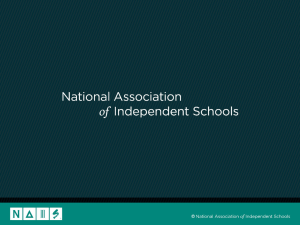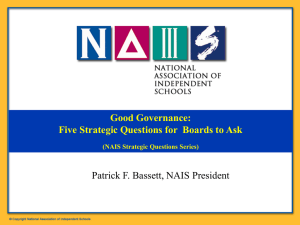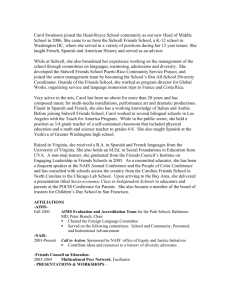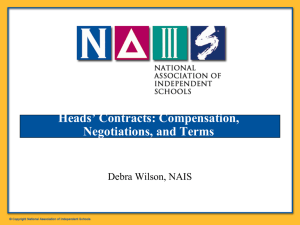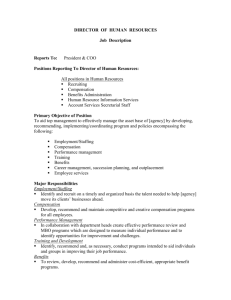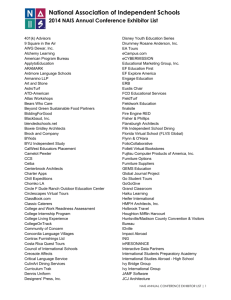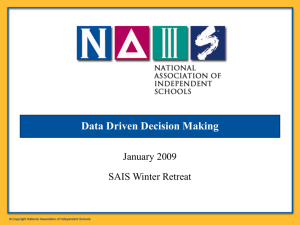Visa Presentation Standards
advertisement
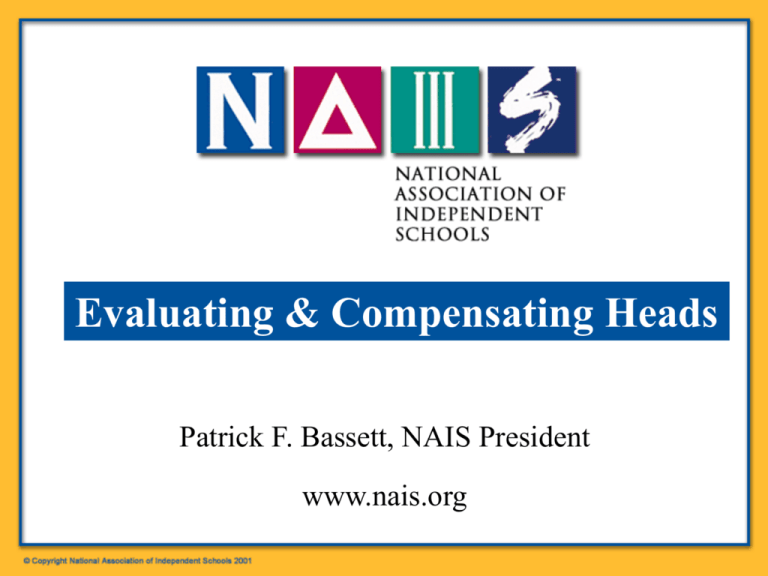
Evaluating & Compensating Heads Patrick F. Bassett, NAIS President www.nais.org Two Challenges How do we evaluate our head responsibly? How do we compensate our head appropriately? Boards Evaluating Heads Job Descriptions for Heads (Education Week Classifieds): Seeking the Ambassador, the General or the Priest? College Prep seeks a leader who… …is responsive to the constituency and understands the significance of genuine communication …is a decisive and well-organized manager who can make tough decisions and be a steward of resources. …is a visionary who can set the agenda for the 21st. century. Schools & search committees are looking for… “God on a good day.” Conundrums of Evaluating Leadership The Real Job (Education Week op ed, 4/12/95, Rob Evans) Wanted: A miracle worker who can… …do more with less …pacify rival groups …endure chronic second-guessing …tolerate low levels of support …process large volumes of paper …work double shifts (75 nights out a year). He or she will have carte blanche to innovate, but… …cannot spend much money …replace any personnel, or …upset any constituency. Boards Evaluating Heads: Leadership Style “Social sector leaders are not less decisive than business leaders as a general rule; they only appear that way to those who fail to grasp the complex governance and diffuse power structures common to the social structure.” ~Jim Collins, Good to Great for the Social Sectors. “True leadership exists only if people follow when they have the freedom not to.” ~Jim Collins, Good to Great for the Social Sectors. It’s important to assess and discuss head style issues and hire or promote complementary upper level leaders. Boards Evaluating Heads: Leadership Style Note: Billy Joel’s tribute to wife, “I love you just the way you are” corresponds to the search committee’s assessment of new head. Incidentally, not too long after the song’s release, Billy Joel dumped his wife for supermodel Christie Brinkley. Heads should consider administering the Myers-Briggs Personality/Leadership Assessments to their Leadership Team: Where do we have gaps in style & approach? How can the team balance and supplement the head’s style? Myers-Briggs Z+2 Model I/E (introvert/extrovert); S/N (sensing/intuition); T/F (thinking/feeling); J/P (judging/perceiving) Adapted from The Zig-Zag Process for Problem Solving, pages 161-163, People Types and Tiger Stripes, 3rd edition, 1993, by Gordon D. Lawrence. Gainesville, FL: Center for Applications of Psychological Type. S (Sensing): What problem are we trying to solve? What are the facts, details, frequency? T (Thinking): What are the criteria by which we should make this decision? What is the logical way to address the problem? How do you process info? How do you make decisions? N (iNtuition): What are the patterns and theories for why this might be happening? How do we brainstorm solutions? F (Feeling): What is the impact on people? How can we deliver this info in the best way to get results? Conundrums of Evaluating Leadership Board View of the Head’s Job What’s Important How To Evaluate Conundrums of Evaluating Leadership: The 14 Skill Sets of the Job Board Chair Priority Order for Head’s Work (NAIS Poll, 1991) 1. Climate and Values 2. Work with Trustees 3. Curriculum 4 Strategic Planning 5. Ensuring Financial Well-being 6. Managing Effective School Policies 7. Public Relations 8. Conflict Management 9. Recruiting Faculty 10. Salaries and Benefits 11. Counseling Personnel 12. Discipline 13. Fund-raising 14. Teaching Conundrums of Evaluating Leadership Trustees Priority Order ’91 Poll Heads Priority Order ’91 Poll 1. Climate and Values 4 2. Work with Trustees 11 3. Curriculum 5 4 Strategic Planning 10 5. Ensuring Financial Well-being 12 6. Managing Effective School Policies 8 7. Public Relations 7 8. Conflict Management 6 9. Recruiting Faculty 9 10. Salaries and Benefits 14 11. Counseling Personnel 3 12. Discipline 2 13. Fund-raising 13 14. Teaching 1 The Problem: No match-up in priorities: Boards wanted CEOs, and Heads wanted to be head-masters. Conundrums of Evaluating Leadership Board Chair Priority Order (2001) vs. 1991 Rank vs. 2006 Rank 1. Climate and Values 1 1 2. Recruiting Faculty 9 2 3. Strategic Planning 4 4 4. Ensuring Financial Well-being 5 5 5. Managing Effective School Policies 6 3 6. Work with Trustees 2 7 7. Fund-raising 13 6 8. Public Relations 7 9 9. Curriculum 3 8 10. Salaries and Benefits 10 12 11. Conflict Management 8 10 12. Counseling Personnel 11 11 13. Discipline 12 13 14. Teaching 14 14 Conundrums of Evaluating Leadership Board Chair vs. Head Priority Order (NAIS Poll 2006) Chairs 2006 Heads 2006 1. Climate and Values 1 2. Recruiting Faculty 2 3. Managing Effective School Policies 6 4. Strategic Planning 4 5. Ensuring Financial Well-being 3 6. Fund-raising 7 7. Work with Trustees 5 8. Curriculum 10 9. Public Relations 8 10. Conflict Management 9 11. Counseling Personnel 11 12. Salaries & Benefits 12 13. Discipline 13 14. Teaching 14 The New Reality: Strategic match-up in priorities. The Lesson: Co-define “high impact” activities for this time at this school. The Perfect Head of School (Walter Ebmyer, ISM, 1980) The Perfect Head of School always has the right thing to say…wears good clothes…buys good books…is 29 years old with 40 years of experience…smiles all the time…visits 15 classes per day and is always in the office to be available for instant parent conferences…etc. The Perfect Head of School is always in the next nearest school (not yours). If your head does not measure up… Send this notice to six other schools that are tired of their heads, too. Bundle up your head and send him or her to the school on the top of the list. In one week you will receive 1643 heads--and one will be perfect: Have faith in this letter. One country day school broke the chain and got its old head back in less than four months. Head/Board Evaluation Principles The head of school is the board’s employee (and only employee): it is the board’s responsibility to evaluate the head, not any one else’s. The entire board, and not just the Executive Committee, should be involved. This process should occur on an annual basis, in June. Head/Board Evaluation Principles The evaluation criteria (any or all the following): articulated in the context of the job definition: Which of the 14 “skill sets” are most important for this school? (Outcomes suggest professional development or executive coaching focus.) related to the school’s success (“dashboard indicators” of admissions, retention, giving, outcomes for students, etc.) linked to the strategic plan of the school, the mission, and/or the specific goals set for the year. incorporated in NAIS’s PGPs/BoardSource’s online Head Assessment Tool (HAT). Head/Board Evaluation Principles Typically, a board selects a small group of its members as the head’s evaluation committee (3-5, sometimes the Executive Committee) to assemble, distill, and discuss the evaluation results. The results and recommendations of the committee are then shared by the board president and vice-president or president-elect in private, with the school head, and in Executive Session, with the entire board. Objective goals (a small, manageable number of them) for the coming year should be set for the head (as they should also be set for the board…and the school). Head/Board Evaluation Principles Public endorsement of the head follows, building political capital. Why do some heads derail? Hoisted on the petard of the change agenda. Misreading the culture. The “substance” rule. Why do the same problems results in different outcomes at differing schools? How does the board integrate evaluation with head compensation? Meet its fiduciary duty to compensate appropriately but not excessively (and produce a “safe harbor” rebuttable presumption checklist to satisfy IRS-required due diligence? Head/Board Evaluation Principles Once evaluation is complete, then… “Show me the Money” Salary Negotiations: Intermediate sanctions obligations to document top salaried employees' compensation (head and CFO) are related to performance assessment and market comparables. Due diligence itself is rather onerous: one-time assessment for multiple-year contract may be an attractive option (repeated at the end of each contract term and with yearly compensation benchmark reports from NAIS to make sure the total comp remains within appropriate ranges.) Head Compensation: Fair, Competitive… AND Defensible Issues of Public Transparency and Scrutiny – 990s on Guidestar.org – Abuse & Scandal in the Non-profit World – IRS & State Attorney Office Interest in Not-for-Profit Operations – Good governance in the age of SarbannesOxley Head Compensation: Fair, Competitive… AND Defensible Safe Harbor/Rebuttable Presumption Processes to Avoid IRS Intermediate Sanctions for “Excessive Compensation” Identify & benchmark peer groups by geography, budget, size, endowment, and anything else deemed relevant. Look at ALL compensation, including things that are not actually taxable, but are benefits (health premiums paid by the school, etc.). See NAIS advisory online, Intermediate Sanctions Update and the StatsOnline Comp Survey, Part III for categories of compensation. Head Compensation: Fair, Competitive… AND Defensible Safe Harbor/Rebuttable Presumption Processes to Avoid IRS Intermediate Sanctions for “Excessive Compensation” For high-end divergences from the mainstream of one’s benchmark groups, develop rationales: e.g., positive evaluations; national rather than local comparisons; higher offers from other institutions raiding your stable, etc. Document, document, and document again the data, the discussion with the entire board, and the vote to approve the compensation package. Goal: Fair, Competitive, Defensible Compensation Package It’s important to make your head happy… but not ecstatic. CAIS-CA: NAIS members AND non-NAIS members CAIS-CA: NAIS members only NAIS Customized Reports Governance Case Study: Clash of Styles Download from: http://www.blueskybroadcast.com/Client/NAIS/Case/case.html The Brutal Facts: • Head is in his fourth year of a very successful run in terms of school growth, parent satisfaction, and introduction of new ideas. • A highly respected segment of the senior faculty, however, is not happy with many of the changes and begins to express its unhappiness to their friends on the board. • Prior to the April evaluation session by the board of the head, a senior faculty confides to the board chair that there is a movement afoot for faculty to vote “no confidence” in the head. • What’s the board do now? Governance Case Study: Clash of Styles NAIS Position: How to handle a faculty revolt. • Examine openly the extent to which board members have neglected to cut-off such “off the record” complaints. • Co-define with the head “what’s important” and “high impact” activities, and evaluate the head accordingly, the “substance” rule. • Recommend that the head conduct a “school climate survey” among the faculty and staff to ascertain the health of the climate and to seek counsel on how to address issues to improve it if necessary. • Boards must know the role of and boundaries for the faculty. The End! For More Resources on this Topic, Go to www.nais.org Appendix: Related Slides Patrick F. Bassett, NAIS President www.nais.org
